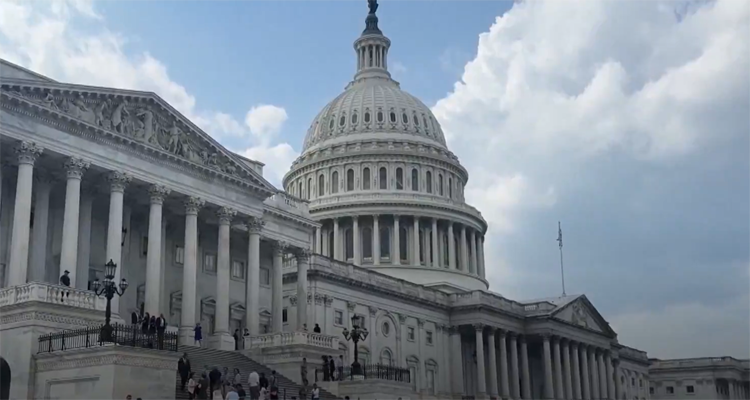
Washington, D.C. : A new chapter in American politics unfolded today as the U.S. federal government officially shut down at 12:01 a.m. Washington time (10:31 a.m. IST) after Congress failed to approve emergency funding.
The White House had already instructed federal agencies to brace for the impact. From today, government offices, national parks, research centers, and all non-essential services remain closed until further notice.
Millions Affected, 7.5 Lakh Workers Furloughed
About 750,000 federal employees have been ordered home without pay, while another several hundred thousand in “essential services” — military, border security, police, emergency responders — will keep working without paychecks. Air traffic controllers and TSA staff will remain on duty, but travelers have been warned to expect delays and disruptions at airports.
Key government data releases, including GDP and unemployment reports, have also been suspended.
The US government has partially shut down after the Senate failed to agree on extending funding for federal services pic.twitter.com/j4xHmzj5JD
— TRT World (@trtworld) October 1, 2025
Trump Warns of Job Cuts
President Donald Trump, anticipating the shutdown, had earlier said it would “probably happen,” warning that a large number of federal workers could eventually lose their jobs. The Office of Management and Budget has already asked agencies to prepare “reduction-in-force” plans — a step that could pave the way for permanent layoffs.
🚨BREAKING: President Trump on the looming Government shutdown.
“This is all caused by the Democrats; they asked us to do something that’s totally unreasonable. They never change; they want to give money away to people who entered our country illegally.” pic.twitter.com/U3IpIHo4nY
— The Patriot Oasis™ (@ThePatriotOasis) September 25, 2025
Political Blame Game
The shutdown — the first in six years — followed a decisive 55–45 Senate vote that fell short of the 60 votes needed to pass a temporary funding bill.
-
Democrats pressed for the inclusion of extended subsidies under the Affordable Care Act and opposed cuts to Medicaid.
-
Republicans insisted that health care debates be kept separate from government funding, demanding tighter budget controls instead.
Opinion polls suggest the public may hold Republicans more accountable: around 45% of voters blame the GOP, while 32% point fingers at Democrats.
Economic Impact Looms
The last prolonged shutdown in 2018–19 lasted 35 days, costing the U.S. economy nearly $3 billion in permanent losses. Analysts warn that the current crisis could be equally damaging, disrupting federal contracts, halting small business loans, delaying paychecks, and hurting tourism and travel.
The U.S. Travel Association estimates the shutdown could cost the travel economy $1 billion per week if it drags on.
A Global Image Problem
Beyond domestic disruption, the shutdown threatens America’s global reputation. A nation unable to keep its own government open, critics say, risks sending a troubling signal about its political stability and fiscal discipline.
What next? The standoff will now force Democrats and Republicans back to the negotiating table. Unless a compromise emerges quickly, Americans could be staring at a prolonged crisis with far-reaching consequences — from payless soldiers to a shaken global market.
US Shutdown: 5 Things to Know
The United States government has officially entered a shutdown — the first in six years. Here are the five key takeaways every reader should know:
1. Why Did the Shutdown Happen?
The Senate failed to pass a temporary funding bill. The vote ended 55–45, short of the 60 needed.
-
Democrats wanted Affordable Care Act subsidies included.
-
Republicans pushed to keep health care debates out of the funding process.
2. Who Is Affected?
Around 750,000 federal employees are furloughed without pay. Another chunk, including the military, border security, police, and emergency services, must keep working but won’t be paid until funding resumes.
3. What Will Shut Down?
-
Federal offices and non-essential services
-
National parks and research centers
-
Government data releases, including GDP and unemployment reports
-
Travel delays expected as TSA staff and air traffic controllers work without pay.
4. What’s at Stake Economically?
The last shutdown in 2018–19 cost the economy nearly $3 billion in permanent losses. Experts warn this one could:
-
Slow growth, delay federal contracts and small business loans
-
Cost the travel industry $1 billion a week if it drags on
-
Hit consumer confidence and worker households directly.
5. Who Gets the Blame?
Polls show 45% of voters blame Republicans, 32% blame Democrats, while the rest blame both sides. Political fallout could be as damaging as the economic one.
Until Congress strikes a deal, America faces frozen services, unpaid workers, and mounting costs — a political standoff with real consequences at home and abroad.
US Shutdown 2025: FAQ
Q1. How long will this shutdown last?
No one knows for sure. It depends on how quickly Democrats and Republicans can strike a deal. The last shutdown in 2018–19 lasted 35 days.
Q2. Will the military and police get paid?
They will continue working, but paychecks are on hold. Once the shutdown ends, they will receive back pay.
Q3. What happens to government offices?
Most non-essential services are closed — including national parks, research centers, and routine federal offices.
Q4. Will travel be affected?
Air traffic controllers and TSA staff are working without pay. This means travelers may face flight delays and disruptions.
Q5. What’s the economic impact?
Experts warn the travel industry could lose about $1 billion per week. The last major shutdown caused nearly $3 billion in permanent losses.



